No, direct mail isn’t dead.
In fact, it can have up to 1,300% ROI.
Don’t you want results like that?
Then you need to understand how to write a good sales letter.
It’s one of the most effective pieces of direct mail advertising a business can use to reach customers.
However, a lot of businesses piece together a sales letter quickly and mail it out to a huge list but see no results.
Why is this?
Simply because they didn’t format it correctly or write good enough copy.
Let’s avoid that. Follow along as I teach you how to write sales letters that practically print money.
What is a sales letter?
Before we get into the nitty-gritty, let’s cover our fundamentals.
The definition of a sales letter is the following:
A piece of mail that is sent directly to a potential customer which persuades them to purchase a product.
It’s one of the oldest forms of advertising yet remains very effective. It looks like this:
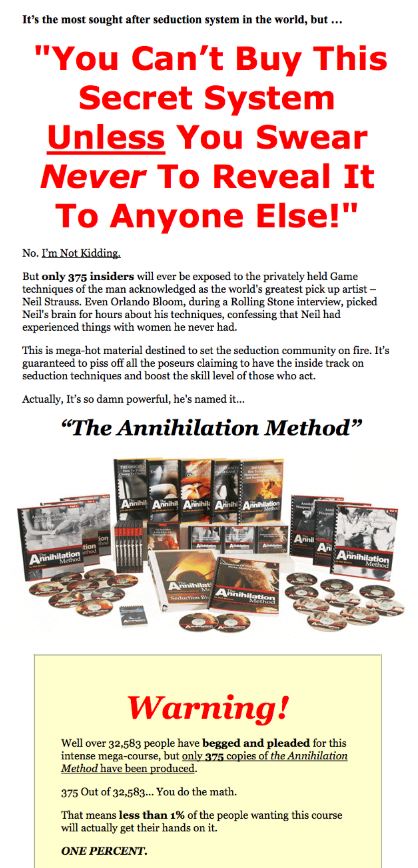
Sales letters can be physical or digital (such as above) and often range up to 10,000 words long.
They are used to sell expensive products and services since customers will naturally have a lot of questions, objections, and concerns.
However, write as many words as needed.
Don’t add fluff and long-winded copy to hit a certain word count goal.
If you can explain it in 5,000 words, great.
If you can explain it in 2,500 words, that’s better.
In general, the simpler and cheaper the product is, the less sales copy you’ll need.
Keep that in your noggin as we continue.
What is The Structure of a Sales Letter?
A sales letter typically follows a structured format that guides the reader through a persuasive journey. You’ll learn more in this article, but here’s a general breakdown:
- Headline: Captures attention and compels the reader to continue.
- Opening: Engages the reader with a problem, question, or relatable scenario.
- Offer and Benefits: Introduces the product or service, emphasizing its benefits and how it solves the reader’s problem.
- Social Proof: Includes testimonials, case studies, or endorsements to build credibility.
- Guarantee: Offers a risk-reversal, such as a money-back guarantee, to alleviate buyer hesitation.
- Call to Action (CTA): Directs the reader on what to do next, like making a purchase or contacting for more information.
- PS Section: A postscript that summarizes the offer, often highlighting a sense of urgency or a special bonus.
What Are The 4 A’s of a Sales Letter?
The 4 A’s of a sales letter form a framework ensuring the content is persuasive and effective:
- Attention: Capturing the reader’s attention with a compelling headline or opening line.
- Appeal: Demonstrating the appeal of the product or service by highlighting its benefits and relevance to the reader.
- Application: Showing how the product or service can be applied in the reader’s life or solving their specific problem.
- Action: Encouraging the reader to take immediate action, with a clear and persuasive call to action.
What Are Sales Letters Used For?
Sales letters are used for:
- Promoting Products or Services: Introducing new products, highlighting features, and explaining benefits.
- Generating Leads: Encouraging potential customers to express interest or sign up for more information.
- Direct Sales: Often used in direct mail campaigns to persuade recipients to make a purchase.
- Building Customer Relationships: By providing valuable information and personalized offers to existing customers.
Are Sales Letters Still Relevant?
Absolutely! Sales letters remain relevant, especially in the digital age. While the format has evolved (from physical mail to email and landing pages), the core principles of persuasive, targeted, and benefit-driven content remain vital.
They are effective in various digital marketing strategies, including email marketing campaigns, website landing pages, and social media advertising.
The key is adapting the traditional sales letter format to modern platforms and audience preferences.
How to write a sales letter
Direct response copywriting is much different than other forms of copywriting.
It requires precision, research, and experience to write business material that can entice customers to whip out their credit cards on the spot.
Reaching this point takes years.
But, you’re in luck. I’ve already spent years practicing sales letter copywriting so I’ll show you the ropes.
If you want to learn more and get mentorship from me, check out my copywriting mastery training.
Let’s begin with the headline.
Sales letter headlines
David Ogilvy, one of my all-time favourite advertisers, once said the following quote:
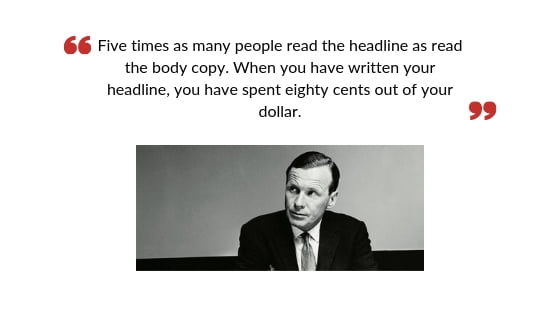
You need to look at headlines and titles to get your foot in the door.
If your headline sucks, nobody is going to read the rest of the copy.
And if nobody reads the copy, you make no money.
That’s why you need to use the following headline writing strategies. Check out my previous guide on headline writing tactics here to learn about these in-depth.
Create a sense of urgency
Some of the most primitive human emotions are scarcity, urgency, and fear.
We can take advantage of this as advertisers by creating urgent headlines.
This strategy makes customers feel like they need to take immediate action or they will not get the opportunity again.
Here’s an example of this technique used in one of Agora Financial’s sales letters:
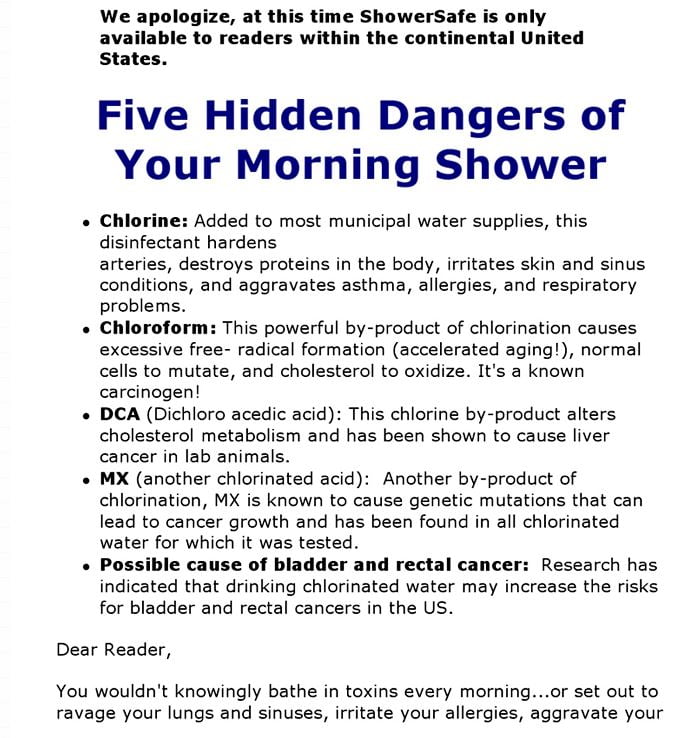
The headline “Five Hidden Dangers of Your Morning Shower” will make the reader feel urgent to learn what these dangers are that they aren’t aware of.
And, as a result, they continue reading the rest of the copy.
You can create urgent headlines like this for a sales letter by using the following power words and phrases:
- Now
- Hurry
- Quickly
- Don’t wait
- Don’t miss out
- Today
- Fast
- Limited time
- Limited offer
- While supply lasts
- Low inventory
- Only a few left in stock
- Discontinued
- Rare
- Secret
You can also use a tool like Jasper to come up with headline ideas lighting-quick!
Don’t be vague, be ultra-specific
Vague and generic headlines don’t tell customers anything.
They are boring and will make them want to throw out your sales letter faster than they opened it.
That’s why ultra-specific headlines work so well.
You can sum up the benefit of the product you’re selling or promotion within the headline.
This gets the reader interested and diving into the rest of the copy which ultimately leads to the sale.
Check out the headline of this sales letter by Frank Kern to see what I mean:
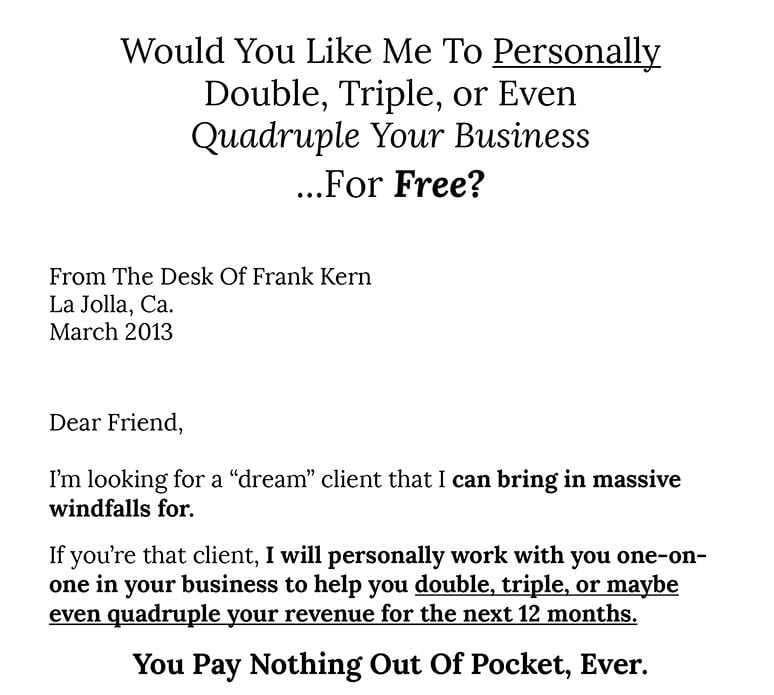
Stating he will increase the reader’s business by 2–4x for free is much more effective than saying something like “I’ll grow your business.”
The numbers paint a picture in the customer’s head of their company being two to four times bigger than it is.
…If a reader is generating $100,000, that could be $400,000.
…If a reader is generating $200,000, that could be $800,000.
You get my point.
Next time you’re crafting a headline for a sales letter, make it as specific as possible.
Include statistics, numbers, and quotes, and give readers a sneak peek of what to expect.
State the customer’s pain points
Why do people purchase products? Because of emotions.
They play a much larger role in the purchasing process than most realize.
Products solve problems. It’s as simple as that. And problems typically involve emotions and experiences.
This is what sparks a customer to look for a solution in the first place.
You can bring out relevant emotions and thoughts with headlines by mentioning one of the pain points of the audience.
Look how Gary Halbert uses emotional headlines that relate to the reader’s situation in this sales letter:
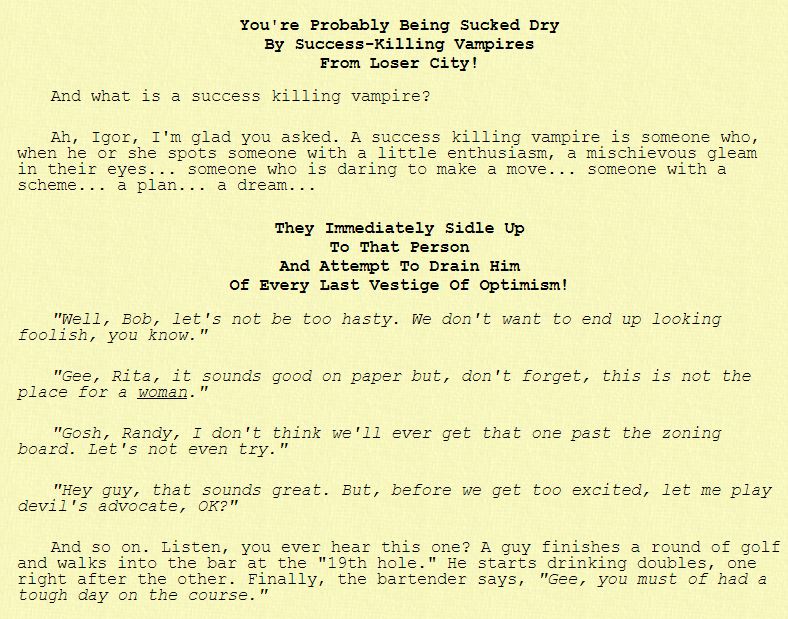
People struggling with negative people will relate to these headlines and feel their associated emotions.
It all leads up to Gary positioning a future product that he’ll be promoting to his list.
That’s why mentioning these experiences in the headline before a call to action is brilliant.
The exact same approach can be used for sales letters.
Mention a pain point that the product you’re selling fixes in the form of a statement or question.
Then, add a call to action at the end of the sales letter, whether it’s a phone number, website, or mailing address to buy the product.
Sales letter introduction
So you’ve written a headline that will give any copywriter a run for their money.
Cool.
But your job isn’t done yet.
You need to keep people on the sales page with a solid introduction.
This is where you want to begin with a question or a bold statement.
If you go the question route, you need to ask something that the customer is already thinking or relates to their situation.
Agora Financial did this in a sales letter for a health report.
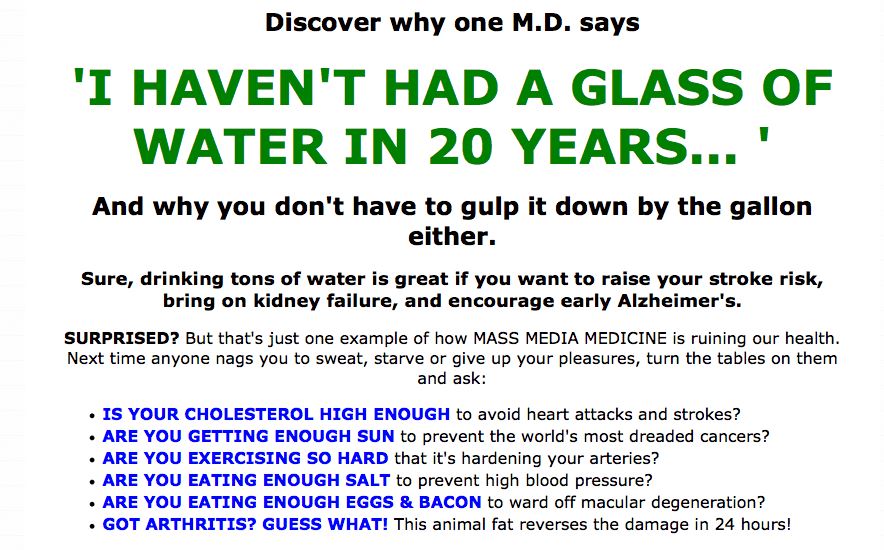
They use bold health statements that catch the reader off-guard followed by “Surprised?”
Most readers will think “Yes!”
This leads me to another point.
There’s a famous copywriting axiom that states you want the customer to say yes as much as possible because they will be more likely to say yes to the sale later.
On the flip side, a bold statement that says something outside the norm can capture someone’s attention easily.
Examples of this could be:
- “Everything you have been told about weight loss is a lie.”
- “If you’re building backlinks to your website, STOP right now before it’s too late.”
- “What you’re going to learn today will change you forever.”
After capturing their attention, it’s time to display a unique value proposition.
A UVP is what makes you different or special.
It can be in the form of a headline, bullets, or paragraphs of text.
Explain in detail what makes your product so amazing that they won’t be able to find anything else like it.
Perhaps it contains rare ingredients, secret methods no one else is sharing, etc.
Continuing with the previous Agora example, you can see that the value proposition of their offer is health breakthroughs you can’t get elsewhere.
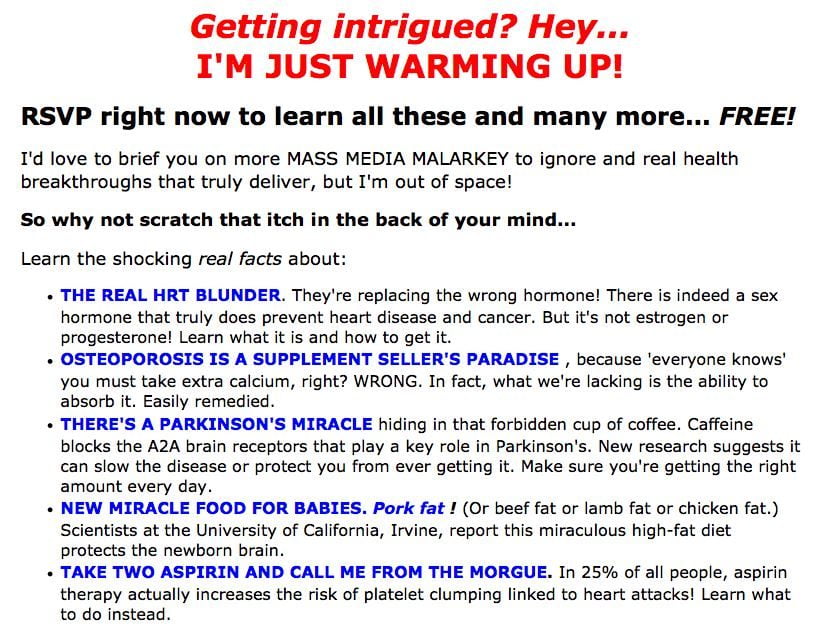
Thirdly, I suggest using storytelling.
It’s an effective way to garner attention and get the reader to harmonize with the advertisement.
The story should relate the pain points, problems, feelings, and experiences of the customer.
You can use a personal story, one from a previous customer, or a fictitious story as long as it doesn’t make any uncompliant claims.
For example, don’t say “Joe Bob used our business system, lost 100 lbs, makes $100,000/hour, and lives on Mars.”
You might get a knock on the door from the FTC for that one.
Check out this sales letter written by legend Gary Halbert.
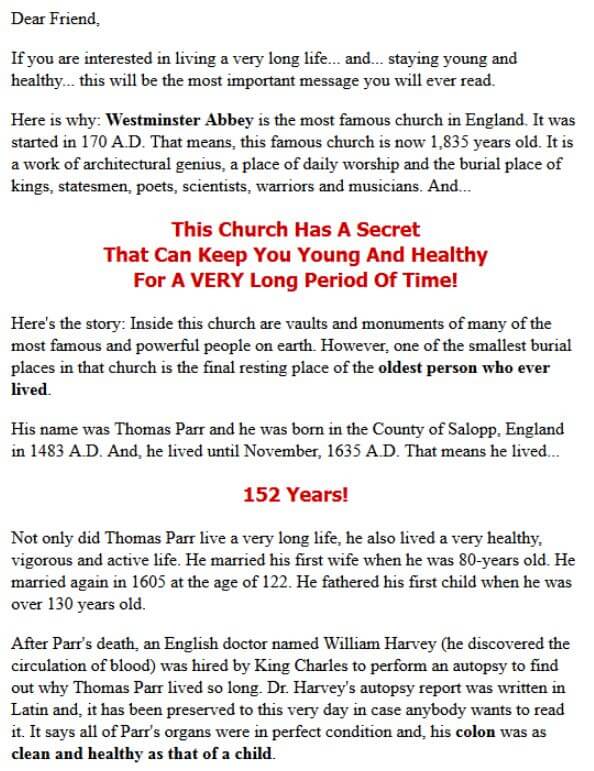
The letter, selling a colon cleanse offer, starts off by talking about a famous church in England. Gary writes and explains the history of the church and how it’s keeping a secret that can keep readers young and healthy.
He introduces a character, Thomas Parr, who apparently lived for 152 years and used these secrets.
Gary Halbert uses storytelling in other ways throughout the sales letter too like talking about findings from a Nobel Prize-winning scientist.
This makes the sales copy exciting and interesting. It isn’t boring or bland. These stories add context and create a feeling of suspense.
They also relate to the offer which he smoothly translates into later.
Writing the body
With the headline out of the way, you can now begin writing the body of the sales letter.
There are a few copywriting formulas I recommend using which include the following:
AIDA
This acronym stands for attention, interest, desire, and action.
The formula consists of grabbing the attention of the customer, making them interested in reading more, creating a desire for the product, and having them take action.
Attention is created with an awesome headline. Use one of the strategies I just taught you to get their eyes glued to the page.
Furthermore, look at how this sales letter from Popular Mechanics promises a free DIY encyclopedia within the headline to capture attention:
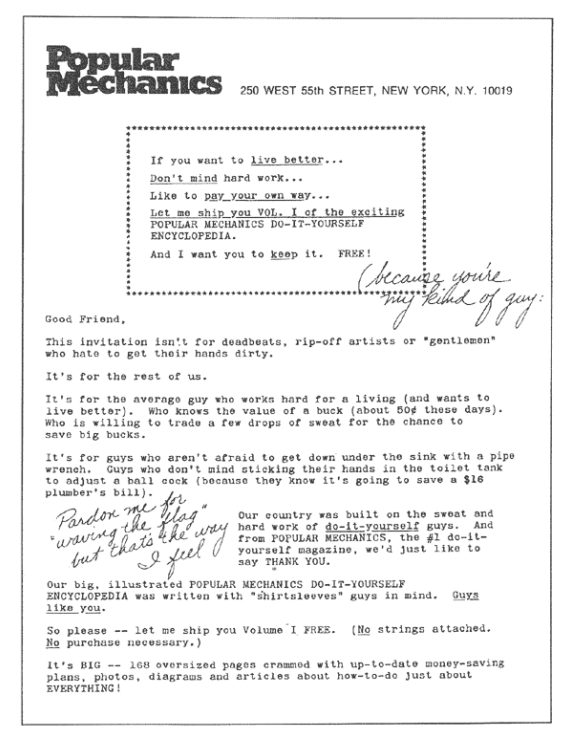
Anyone who enjoys DIY projects would be drooling to learn more!
Interest is then created within the first paragraph by making a bold statement. Using the words “deadbeats” and “rip-off artists” made the writing sound powerful and intriguing.
Focusing the attention toward the reader with phrases such as “Guys like you.” and “Let me ship you Volume I FREE” builds up desire.
The rest of the sales letter includes instructions for placing an order which solves the action part of the formula, as well.
Pain + agitate + solve
An absolutely classic.
There’s no copywriting formula used more than PAS.
It’s simple. It’s easy to implement. And it works really damn well.
The general idea is that you present a pain point that customers are experiencing, agitate it, and then position your product as the solution.
This works because it gets customers feeling emotional, and thinking deeply about their issue, and then your product is more tempting than the Golden Idol from Indiana Jones.
Here’s a sales letter example that uses this technique:
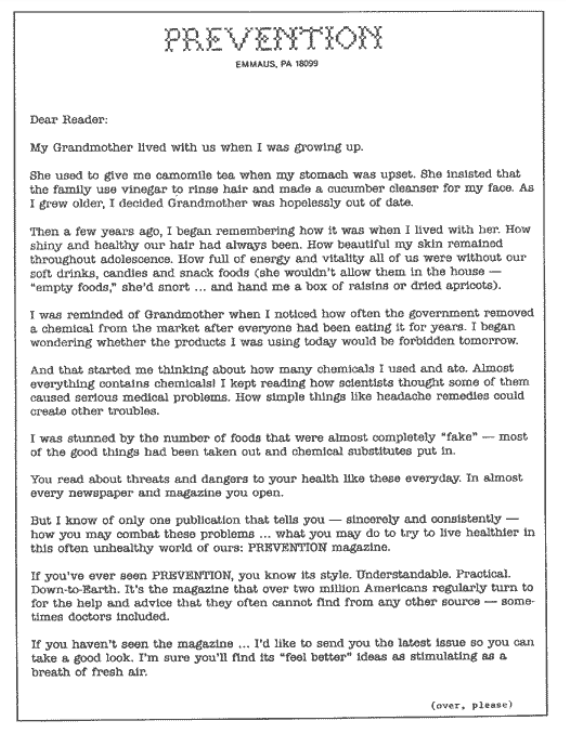
PREVENTION was a health magazine that helped its readers live a healthier lifestyle.
The sales letter speaks about noticing the number of chemicals found in foods and wondering what the negative effects are. This is the pain point of readers.
It continues to elaborate on potential threats and dangers to the reader’s health which is the agitation stage.
Finally, it positions the magazine as the solution for combating health problems and making more informed decisions about diet.
Have a clear buyer persona
A buyer’s persona is an outline of your ideal customer.
It typically covers their demographics, interests, values, feelings, and as much detail as possible.
You can then craft a sales letter tailored to this exact audience which improves conversion rates up to 73%.
Think about it.
If you send out a sales letter to a random mailing list, you’re going to be speaking to random individuals who may not be interested in the product.
However, aligning a buyer’s persona with both the copy and list will drastically improve results.
Here’s a buyer persona template you can fill out yourself:
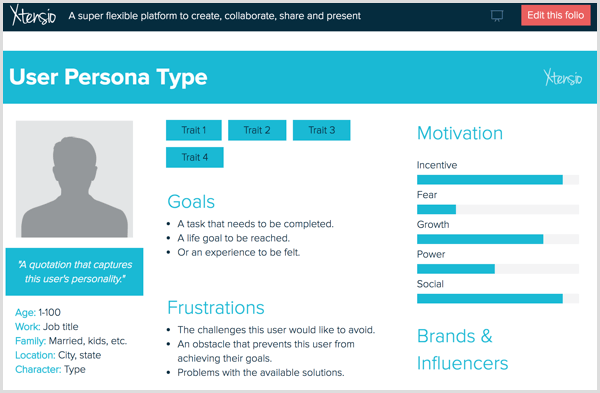
I teach how to effortlessly research an audience when copywriting in my online training, too.
Split test to find winning combinations
Split testing is a normal process in all forms of copywriting.
It allows advertisers to find winning combinations of headlines, calls to action, and other elements of their sales letter.
This is why I suggest split testing these components and others like images.
You can send out a few different versions of a sales letter to a mailing list one at a time.
Record the performance of each campaign and determine if one generates more revenue than the others.
If so, you can effectively double down and mail that out to a much larger list to rack in the big bucks!
If you’re writing a digital sales letter, this is 100x simpler.
Test different pages manually or use software like Optimizely that sends out a control to half of the visitors.
Take advantage of testimonials
An interesting statistic you may not know is that testimonials impact 67.7% of purchasing decisions.
They act as social proof which builds trust with potential customers.
This is why testimonials can be a great addition to a sales letter for increasing conversion rates.
You must first ask previous customers for a testimonial about their experience with your product and service.
Take these and include the best ones in your sales letter. You can add them after speaking about the benefits of the product to testify to its effectiveness.
Some simple reviews like the ones found on this cryptocurrency program sales page are more than enough:
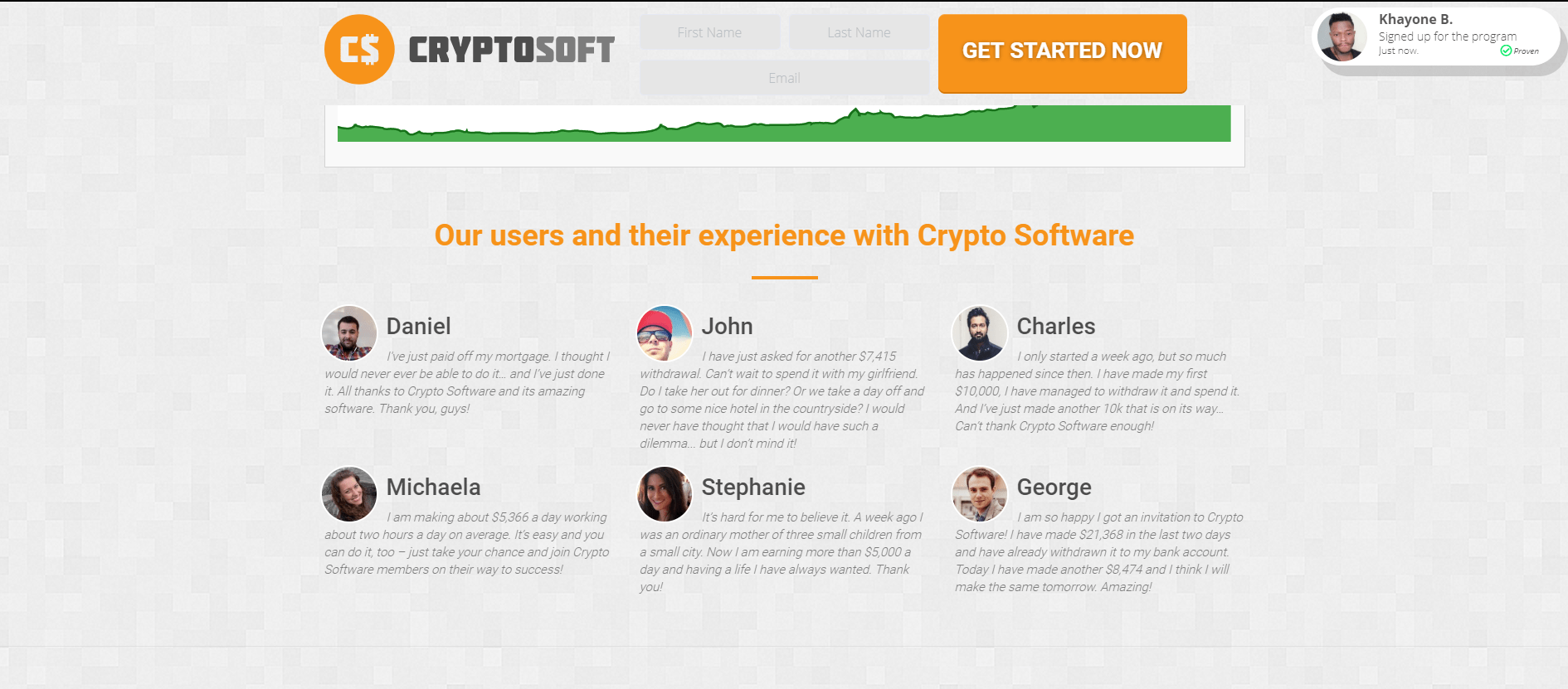
Justify the price
Being able to logically and emotionally justify the price of a product is a huge element of successful sales letters.
As a general rule of thumb, it requires much less justification to market a $10 product than it does for a $10,000 product, for example.
Here’s why:
Someone spending $10 on an item isn’t a huge investment. They can get a refund, and even if they don’t, it’s not going to bankrupt them.
But let’s step into the customer’s shoes.
If I spend $10,000 on something, it better be the best damn thing I’ve ever used in my entire existence!
Don’t you agree?
A sales letter would have to do a hell of a job explaining to us why a product or service is worth that much.
That’s how most people think, so we can reverse engineer this kind of thoughts to land the sale.
The best way to do so is by positioning the price as an investment.
If you sell a course, book, or other product related to business, career, investing, etc, then you’ll be able to do this effortlessly.
Let’s say your program costs $500. You can explain that they will have the knowledge to make thousands of dollars per month in passive income, so the initial $500 is peanuts compared to what they’ll eventually make.
For those that don’t sell financial products, I know what you’re thinking.
“How the heck do I use this?”
You can still apply this principle to supplements, consumer goods, and everything under the sun.
For example, a business selling weight loss pills can say that their monthly plans are an investment for the customer’s health, happiness, and self-esteem.
Any talented sales letter copywriter like myself will be able to do this effortlessly if you want to outsource your sales letter writing.
Relieve any objections
You want the customer to flow from the top of a sales letter to the bottom like a water slide.
The more interruptions and hiccups they experience in between, the longer it will take to convert them or you might lose them all together 🙁
You can avoid this and increase how many sales you generate by predicting objections users will have and answering them before they’re asked.
This requires you to understand the target audience like the back of your hand.
You want to know their feelings, beliefs, desires, pain points, and demographics.
This allows copywriters like yourself to understand what their critiques will be, and resolve them along with the page.
Common objections or concerns include:
- Pricing
- Refund and return policies
- Privacy policies
- Customer support availability
- Evidence for any claims made
- How long it takes for the product to work
- What the end result looks like
- Exactly how to use the product
If you can clear up questions and objections like these, customers will be able to slice through sales letters like butter and be more confident in what you sell.
Have more CTAs than you can count
Last but not least, you need plenty of calls to action.
These statements and words tell users to take the next action within the sales sequence.
It’s different for every business and product, but it might be to purchase something, add an item to a cart, or sign up for a newsletter subscription.
Look how this sales letter uses more CTAs than you can count:
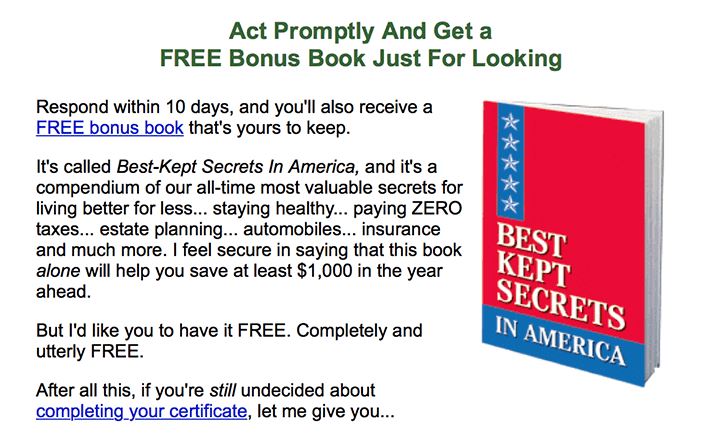
These include:
- “Respond within 10 days”
- “Receive a FREE bonus book”
- “Act promptly”
- “Get a FREE bonus book”
Since customers will convert for different reasons, you will want to place a call to action within every major section of a sales letter.
What I mean by this is that some people may purchase after reading testimonials, but others will after understanding the benefits of the product.
Calls to action are phrases like:
- Sign up today
- Sign up now
- Register
- Buy now
- Don’t wait
- Hurry
- Claim your discount code
- Get your free X
Read my guide on calls to action to understand how to use them effectively and for more ideas.
Use bullets to quickly summarize the value
Bullets are one of your best friends as a copywriter.
They empower you to quickly communicate features, benefits, and other important information.
Use bullet point lists all throughout the sales letter for visual relief and convenience.
Look at this sales letter from Bottom Line Publications, a publishing company known for its incredible copywriting and direct mail.
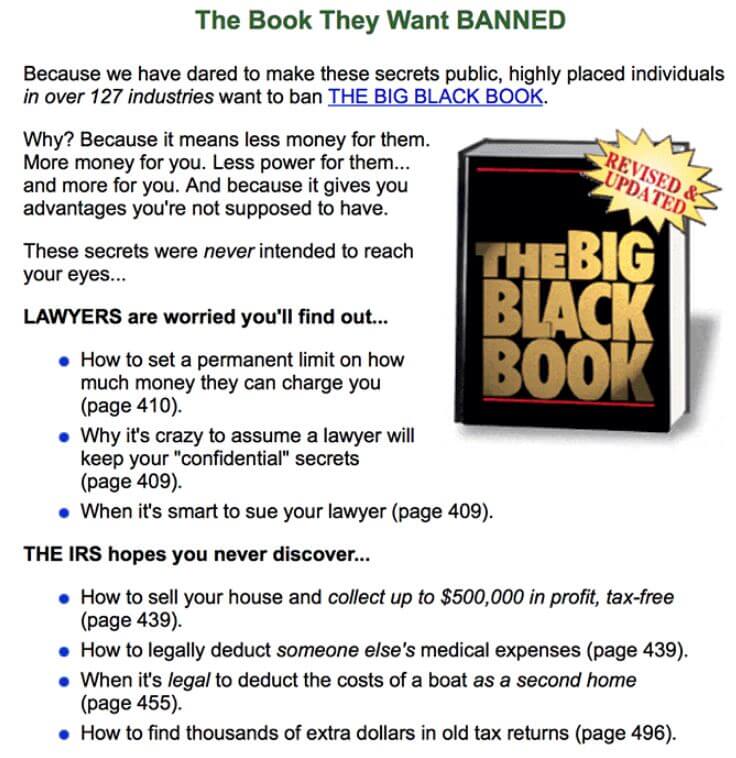
The sales letter is advertising The Big Black Book which contains information about insider health secrets.
All throughout the sales letter including the above section, Bottom Line Productions uses bullet points to summarize features, benefits, and different points they make.
This makes the long sales letter easier to read, visually appealing and helps readers understand the most important information.
Use Jasper to come up with outlines and bullets to speed up the process.
Sales letter template
Phew, I know that’s a lot to take in, so here’s an easy-to-use sales letter format based on the strategies I outlined today.
- A headline that catches the customer’s attention.
- A subhead that backs up the headline
- Video sales letter.
- Section agitating customer’s pain points and experiences or use storytelling to show you understand the reader’s situation.
- Explain what the product is and its UVP.
- Features and benefits of the product.
- Testimonials and reviews.
- Pricing structure.
- Bonuses and how much they’re worth.
- Money-back guarantee and a quick explanation of the refund policy.
- Justification for pricing and offer.
- The P.S.
This is a sales letter formula that has remained tried and true for decades.
Go look at any effective sales letter and you’ll notice that it commonly takes this structure every time.
Why?
Because it works!
It covers all of the fundamental information that customers need to know to purchase a product.
Mix in the other sales letter strategies I shared with you today to maximize its performance too.
Sales letter examples
Last but not least, let’s take a look at some sales letter examples and the techniques used to make them so darn good.
Agora’s Apollo’s Energy
This is a sales letter from Agora Financial that sold a blueprint to making money by investing in new energy companies.
It begins with an exciting headline related to the moon landing and something even bigger around the corner.
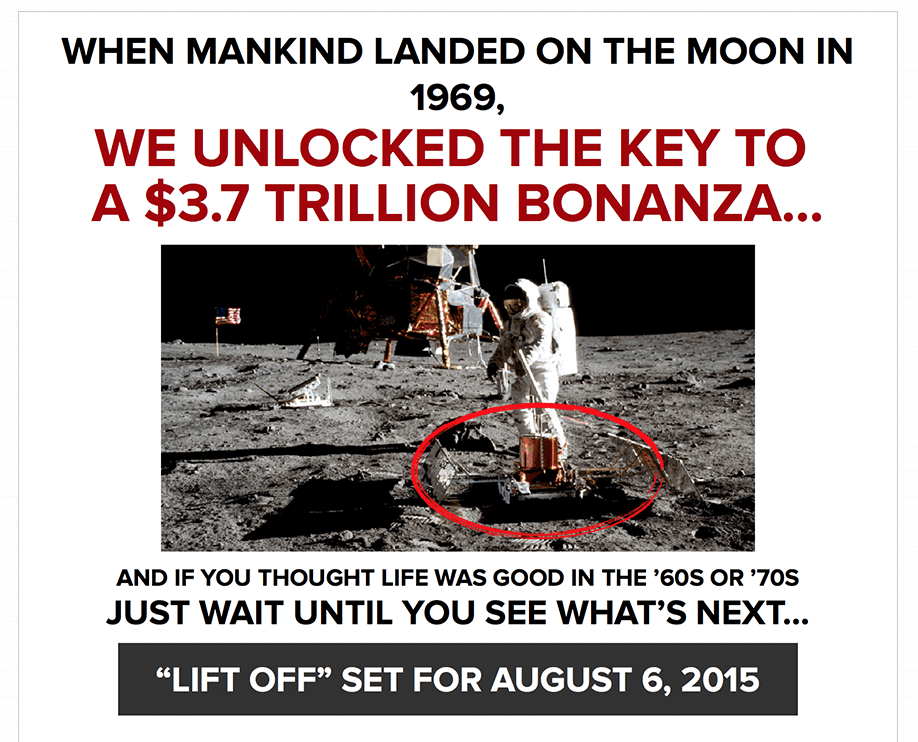
Afterward, it explains the emotional and national impact the original moon landing had on America.
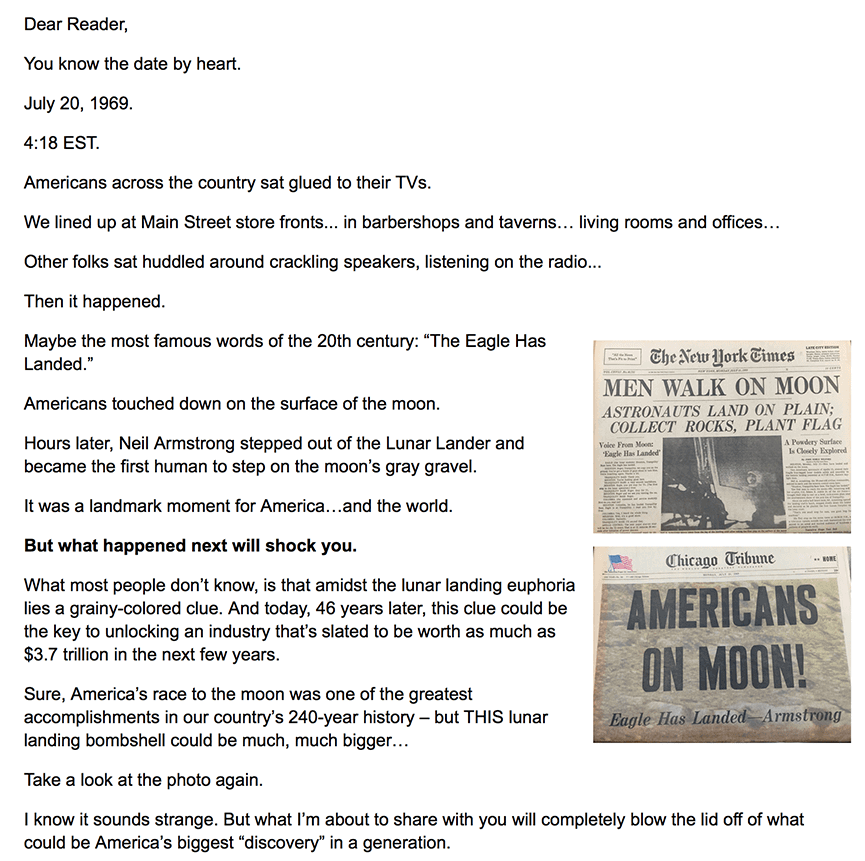
It then presents the idea that the biggest discovery NASA or America has ever seen is happening.
This is known as the concept of anchoring in copywriting. It is the process of tying material like a sales letter to an external event for emphasis, relevancy, and excitement.
Agora elaborates on this new form of energy that was found which can be used to get rich and that readers have to consider it now before missing out on the once in a lifetime opportunity.
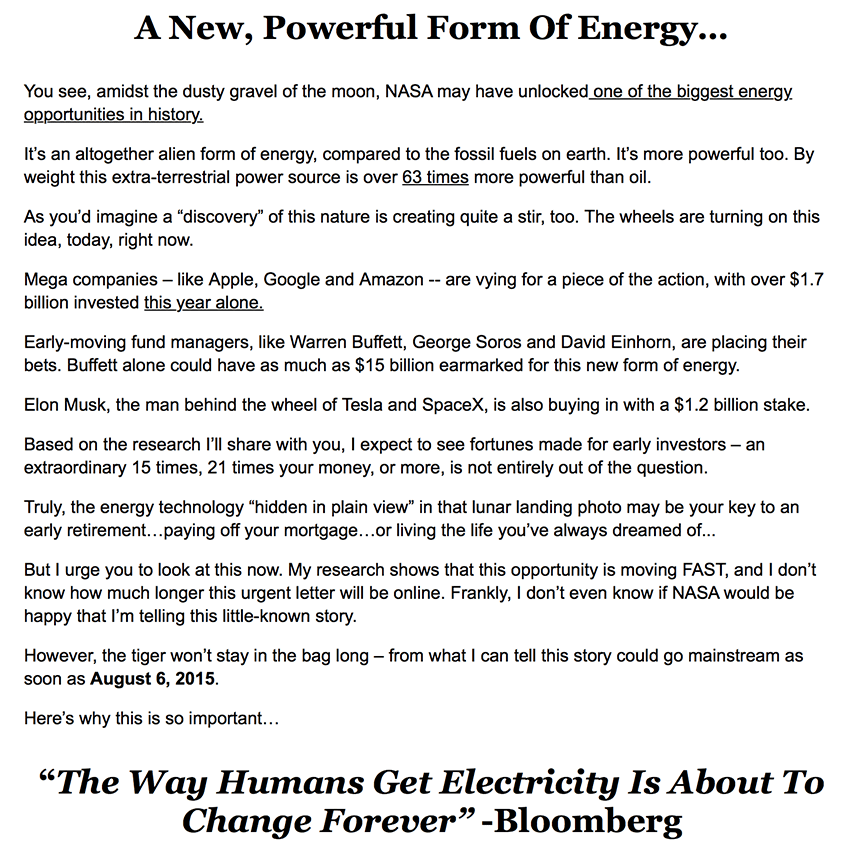
Finally, they present the offer which is the blueprint itself.
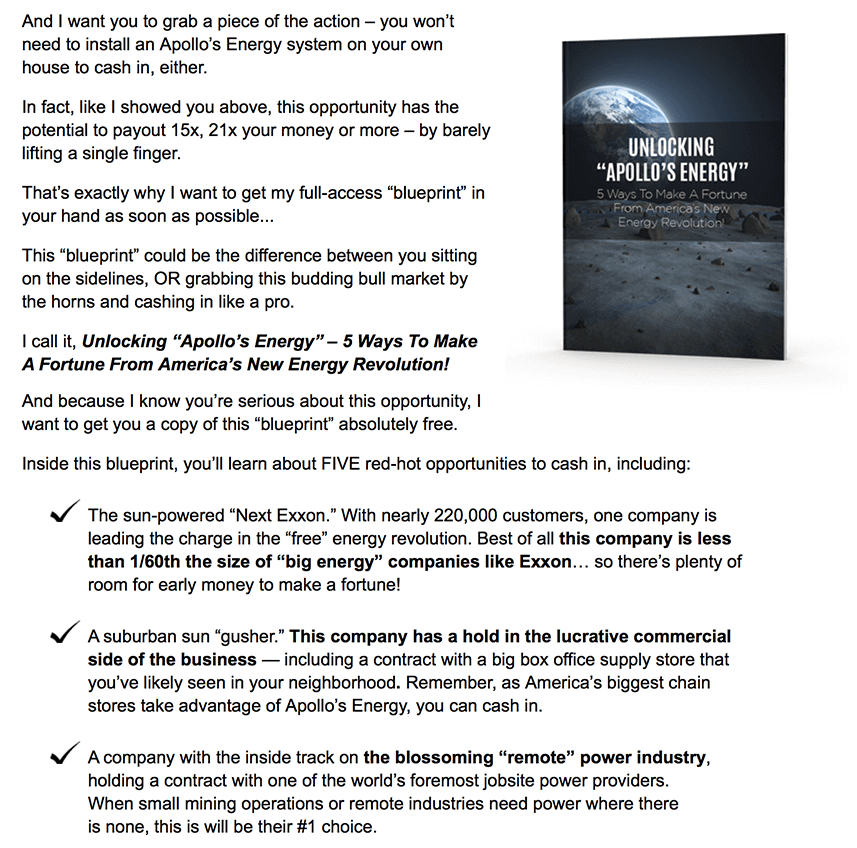
Note how the bullet list summarizes all of the value propositions and benefits of purchasing it.
On that note, watch my video breaking down an Agora Financial sales letter.
Chris Haddad’s dating program
Chris Haddad is an extremely successful and well-known copywriter, especially for his work on Clickbank products.
This is a video sales letter that he created for Michael Fiore’s dating program:
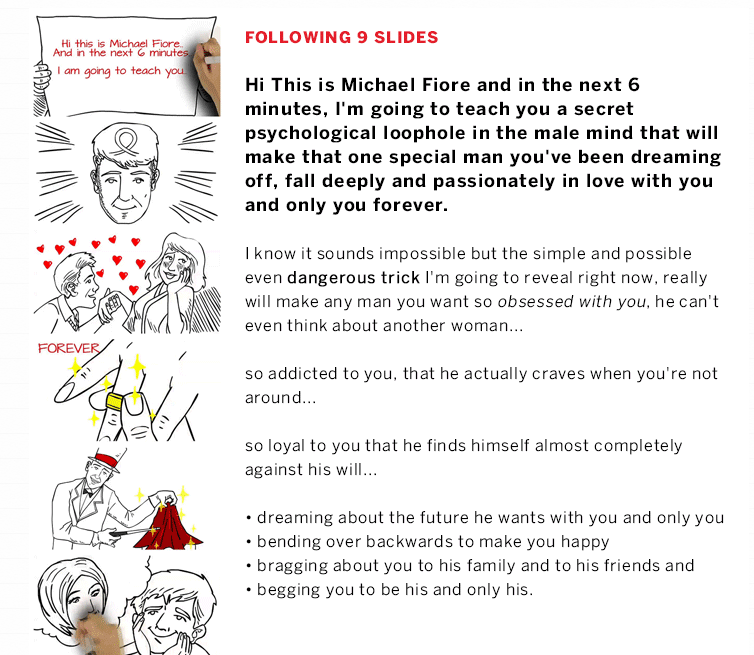
The introduction instantly explains to the audience what they will be getting out of watching a quick six-minute VSL: their deep primal desire of being loved by one person.
He elaborates on the strong desire over the next couple of sentences and bullet points. This creates a powerful emotional reaction.
Social proof is used to establish credibility and authority. Who wants to take dating advice from a schmuck, right?
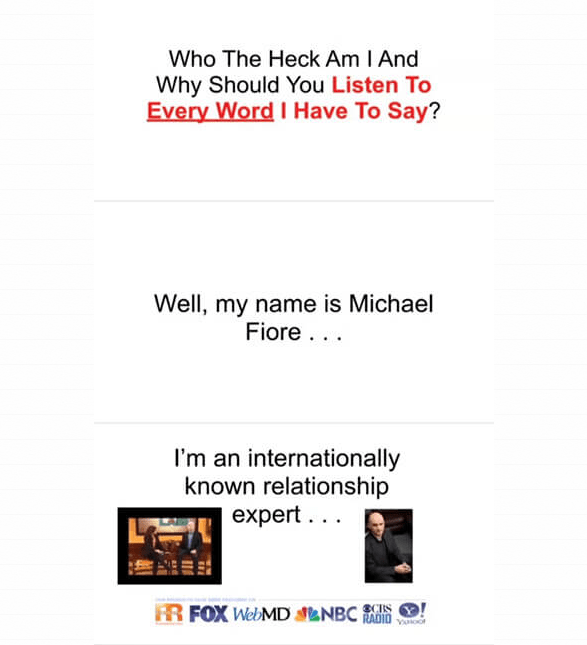
A heavily discounted offer is then presented which makes the product appear irresistible. It also creates urgency.
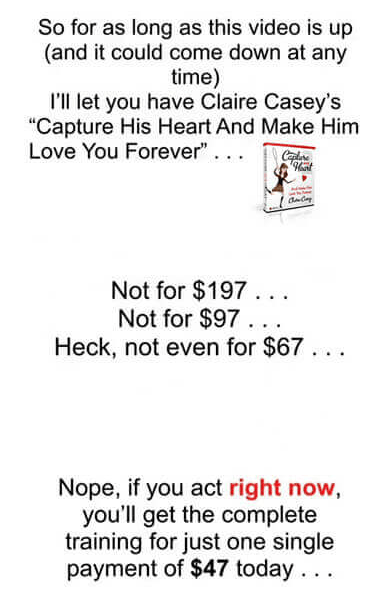
Chris also uses the classic method of presenting free bonuses to ramp up value and conversions.
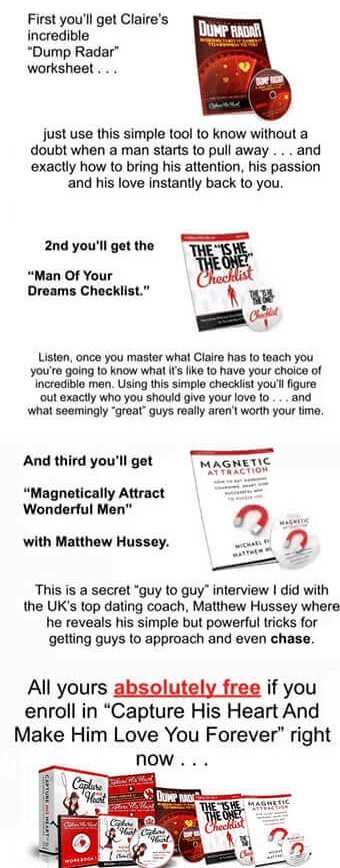
Yours truly
This is the sales letter I wrote to sell one of my online courses, WiseCopy. It teaches people how to grow profitable online writing businesses and freelance for a living.
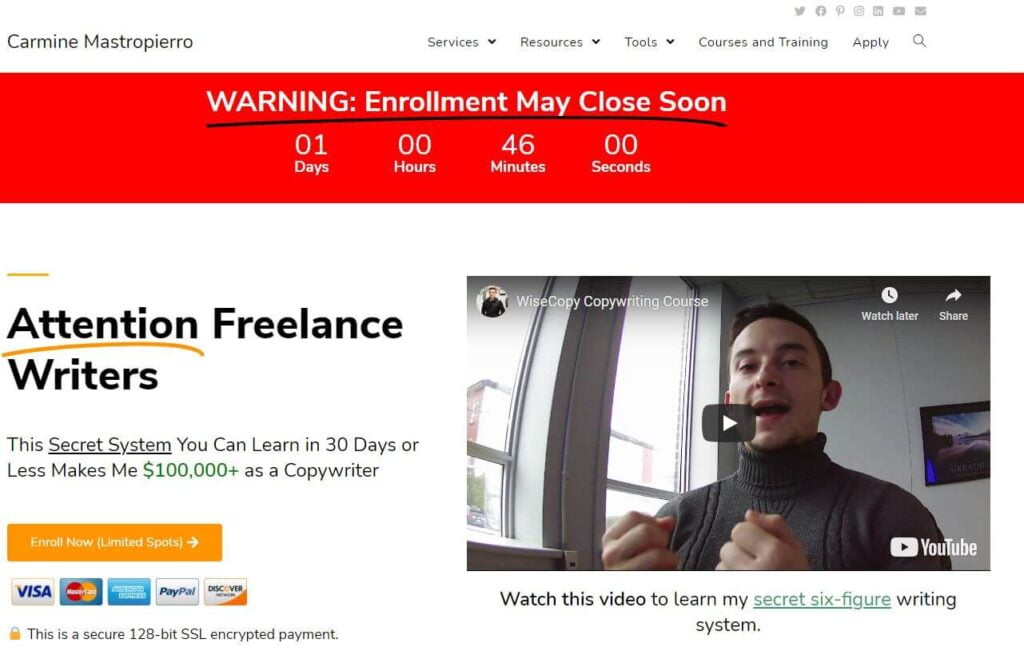
The countdown timer at the top creates a sense of urgency. It pushes users to take action faster and purchase the program.
The headline directly selects the audience: freelance writers. I explained they can learn my secret system that generates $100,000+.
A call to action to enroll (with trust badges) or watch the VSL is placed below this.
The first heading asks a question related to my buyer persona’s situation which is wanting to make money online.
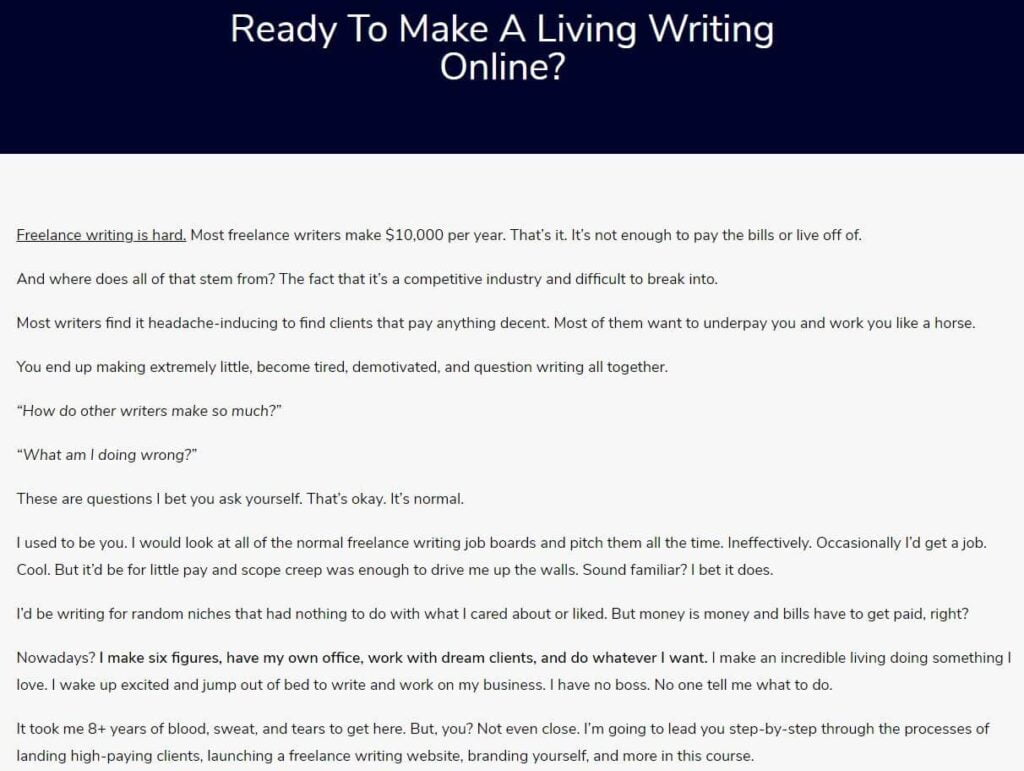
The sales copy begins by agitating the problem which is the difficulty of earning a living writing online.
I explain I was once in their shoes struggling to get work but now make a great living and the program details my step-by-step process.
Feature by feature, I explain what’s in the program and the benefits they will experience like freedom, more income, etc.
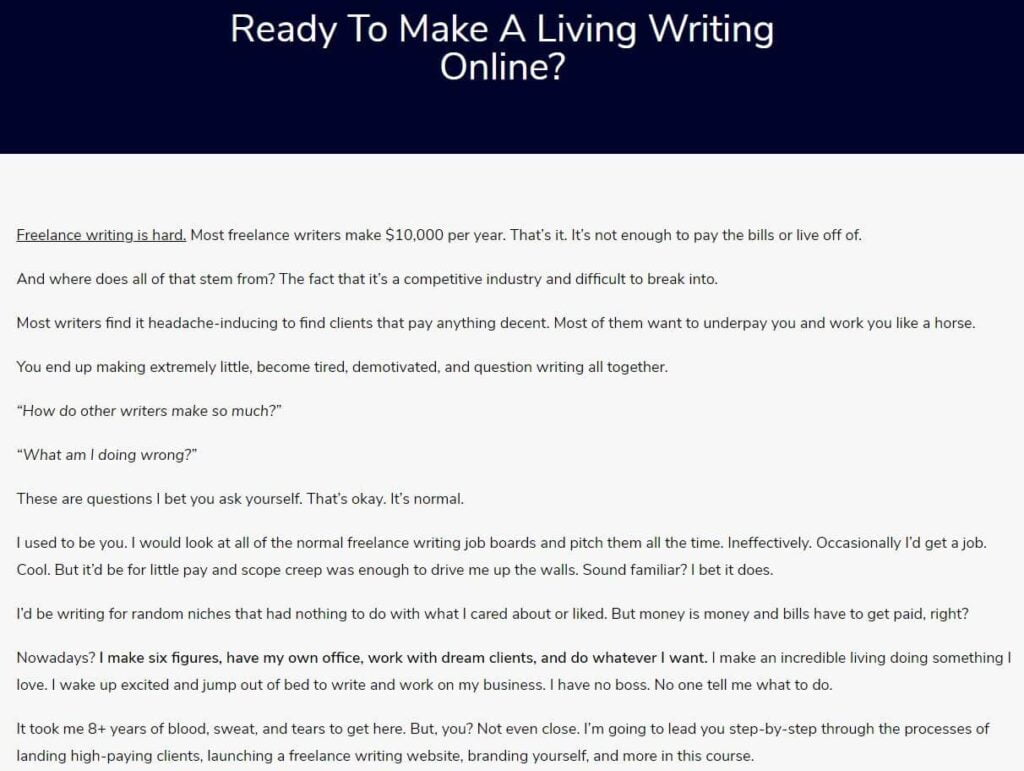
This section speaks about what makes the course better and different. It is both a value proposition and allows me to overcome objections.
I create credibility and authority by showing off some of my clients and experience.
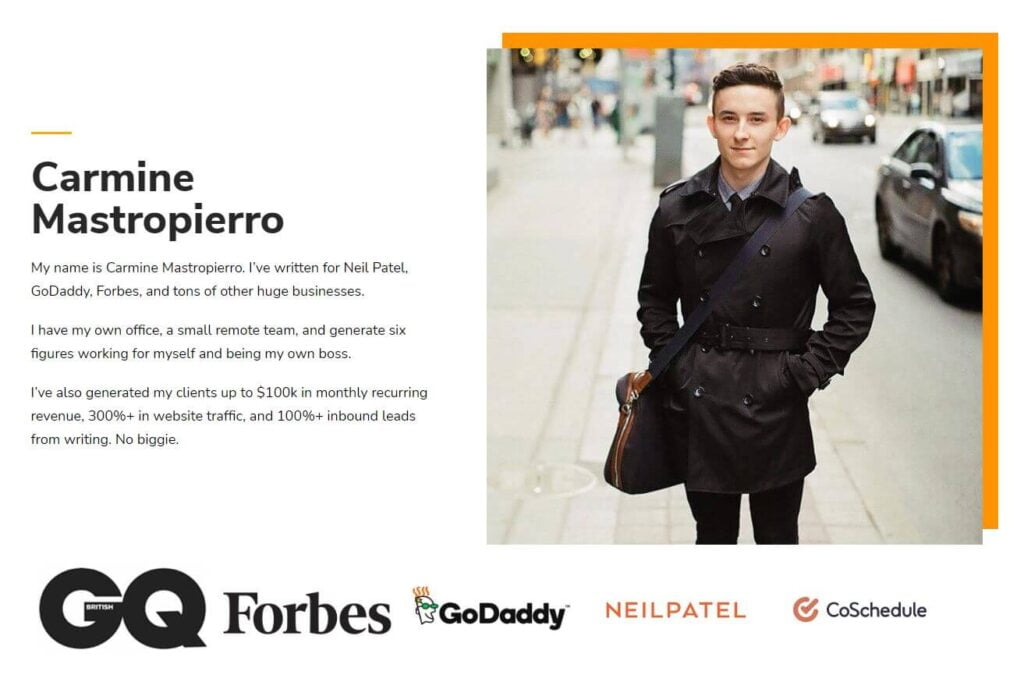
Near the end of the sales letter, I recap what they get, how much it’s worth, and bonuses.
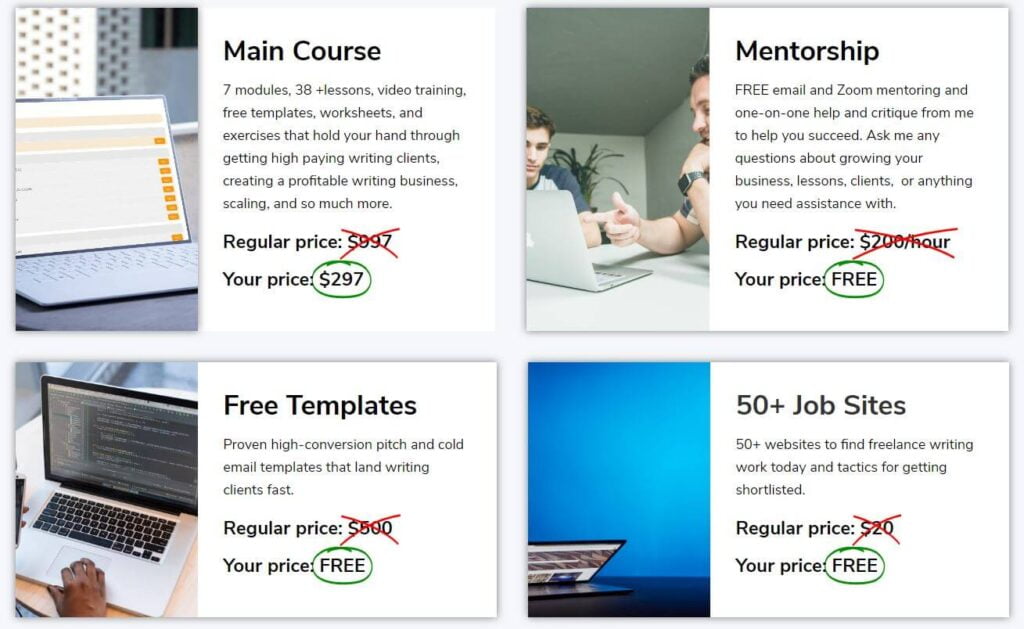
Testimonials act as social proof that the course is worth buying.
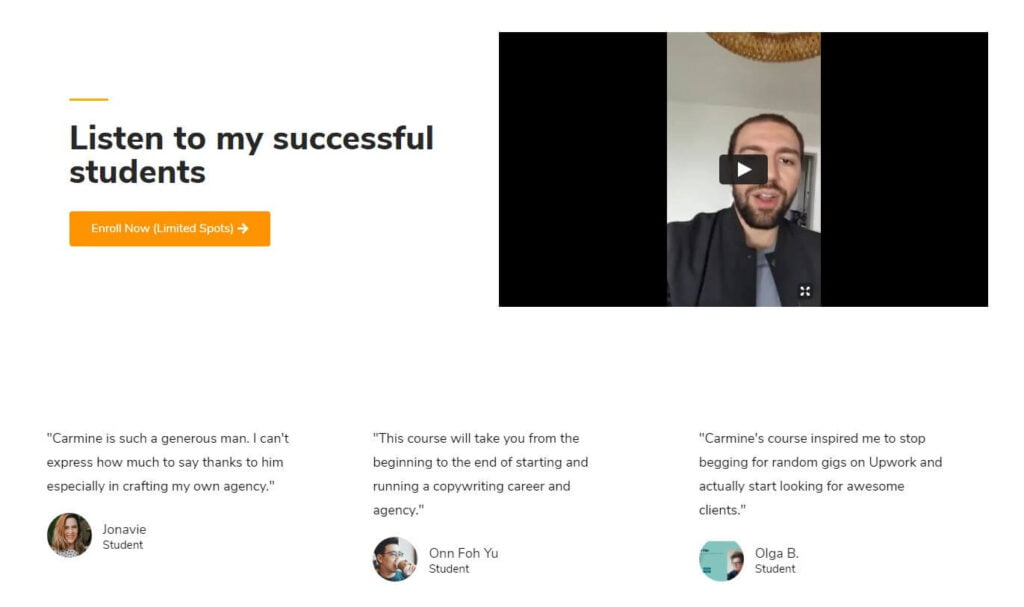
Finally, there are calls to action to buy the program.
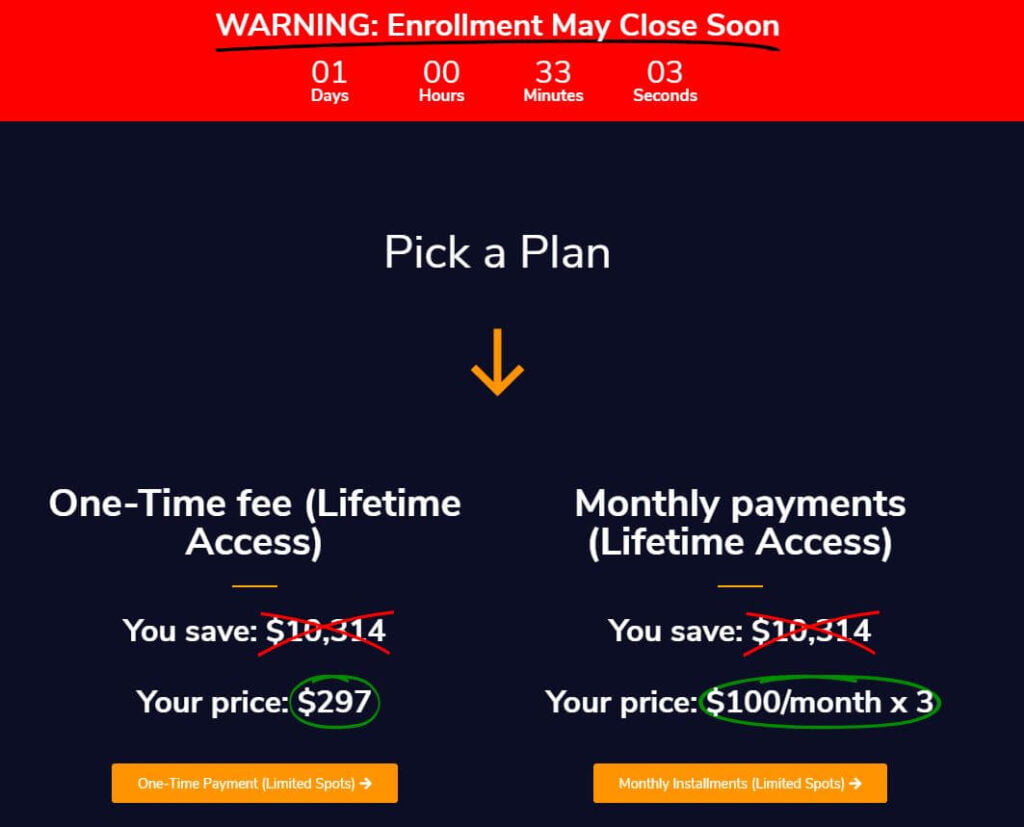
Final thoughts on how to write a sales letter
Direct mail is an effective and cost-efficient approach to generating sales.
It takes very good copywriting to pull off great results, though.
Writing a direct mail sales letter begins with the headline. You need to use urgency, ultra-specific statements, and emotion to capture attention.
Then, using a formula like those I outlined earlier help craft the body of a sales letter that gets customers itching to buy.
You need to end every sales letter with a clear call to action, as well. This might be to call a phone number or visit a website, for example.
Doing these things will result in a sales letter that practically generates free money.
What are you waiting for? Start writing a sales letter today with these strategies and watch the cash roll in!
Alternatively, enroll in my courses to learn more about writing copy.














